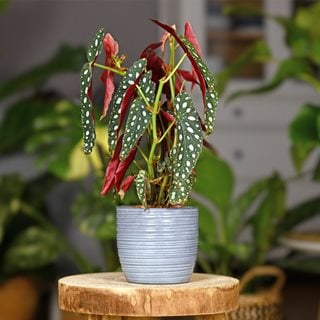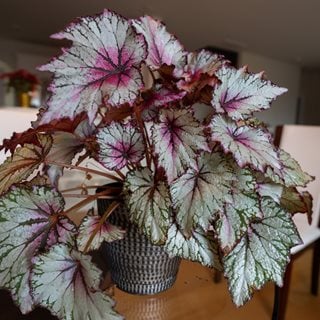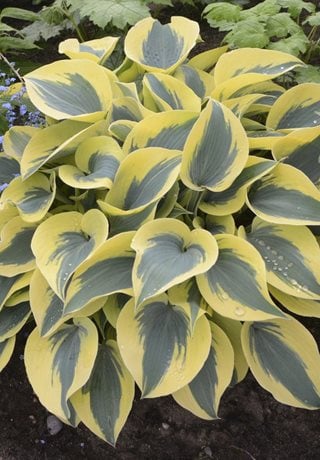7 Tips for Growing Beautiful Begonias Indoors
With the right care, begonias can be vibrant, long-lasting houseplants. Learn the secrets to keeping them healthy and flourishing.
Rieger begonia. Photo by: VeronikaVisuals / Shutterstock
7 Steps for Beautiful Indoor Begonias- Choose the right begonia.
- Provide the right light.
- Don't overwater.
- Fertilize regularly.
- Provide a comfortable environment.
- Prune and deadhead as needed.
- Know when to repot.
Begonias have long been cherished by gardeners for their shade tolerance, colorful flowers, and striking foliage. But did you know that many types of begonias also make fantastic houseplants, allowing you to enjoy their beauty indoors all year long?
Since most begonias hail from tropical and subtropical regions, they naturally thrive in a warm indoor environment—as long as you meet a few essential needs. To keep your begonias healthy and vibrant, follow these simple begonia indoor care tips for watering, sun exposure, fertilization, and more.
1. CHOOSE THE RIGHT BEGONIA
There are thousands of species and cultivars of begonias. Some are grown primarily for their flowers, while others are grown for their striking foliage. While many begonias will do well as houseplants with the proper care, some varieties are better suited to an indoor environment than others.
Rieger or cane begonias (Angel wings): To enjoy beautiful flowers indoors year-round, try Rieger begonias (Begonia x hiemalis) or cane begonias, like angel wings (Begonia coccinea). Rieger begonias are typically winter-blooming plants, while angel wing begonias can bloom several times throughout the year under ideal conditions. In addition to their colorful flowers, angel wing begonias also feature a unique speckled pattern on their leaves, adding to their appeal.
Wax begonias: Although typically grown as garden annuals, you can also grow wax begonias indoors, where they will bloom continuously if placed in bright, indirect light or under artificial lighting. They also have a nicely mounded, compact habit, making them perfect for a desk or tabletop.
Rex begonias: If you want to grow begonias for their decorative foliage, try plants from the rhizomatous begonia group, such as rex begonias (Begonia rex-cultorum) or iron cross begonias (Begonia masoniana). Rex begonias sport leaves with dazzling colors and unique patterns, while iron cross begonias feature textured, deep green leaves with dark cross-shaped markings.
Tuberous begonias: One group of begonias not suitable for growing indoors year-round are tuberous begonias, which die back and go dormant in winter. However, you can overwinter the tubers indoors until it’s time to replant them in the garden in spring.
Learn more about the various types of begonias.
2. PROVIDE ENOUGH LIGHT—BUT NOT TOO MUCH
While most begonias are shade plants in the garden, they need plenty of bright, indirect light when grown indoors to keep their colors vibrant and to ensure flowering.
To give them as much light as possible, without exposure to direct rays, place your begonias near an east- or west-facing window or by a sunny window covered by a sheer curtain. During the winter months or where natural light is lacking, consider putting your plants under grow lights or fluorescent lighting.
“Rex begonias crave bright, indirect light to maintain their vibrant colors. Think of them as sunbathers who prefer a beach umbrella. Direct sunlight can scorch their delicate leaves, so an east- or west-facing window is ideal.” — Stacy Ling, Bricks 'n Blooms
3. DON'T OVERWATER
Begonias thrive in soil that remains consistently moist but never waterlogged, since they can easily succumb to root rot. The simplest way to check if your begonia needs water is to feel the soil. When the top inch is dry to the touch, it's time to water. If you’re unsure, it's generally better to slightly underwater rather than overwater, as excess moisture can quickly lead to problems.
When watering begonias, make sure the excess water drains freely from the bottom of the pot, and always empty the saucer beneath your plants to prevent standing water.
Additionally, avoid getting water on the leaves, which can make plants more susceptible to powdery mildew and other fungal diseases.
“Water begonia plants thoroughly, pouring off the excess water or collecting it in a pebble-filled saucer. This avoids root rot caused by plants sitting in excess water. Using a pebble-filled tray also helps increase humidity around the plant, since the pot sits on the pebbles above the water.” — Melinda Meyers, nationally known gardening expert and author.
4. FERTILIZE REGULARLY
Fertilizing your indoor begonias properly is essential for the production of lush foliage and flowers. Use a balanced liquid fertilizer (such as 10-10-10 or 20-20-20) for general growth. If you're encouraging blooms, a fertilizer higher in phosphorus (like 15-30-15) can help.
Because begonias are sensitive to fertilizer buildup, dilute the fertilizer to half-strength and apply it every two to four weeks during the growing season (spring and summer). As begonias slow their growth during the cooler months of fall and winter, reduce the frequency of fertilizing to once every six to eight weeks or stop altogether to prevent overfeeding.
If you prefer natural fertilizers, you can also use compost tea, fish emulsion, or worm castings to deliver gentle, slow-release nutrients.
5. PROVIDE A COMFORTABLE ENVIRONMENT
Indoor begonias thrive in warm temperatures and high humidity, which mimics their natural tropical habitat. For optimal growth, aim for humidity levels of 50% to 60%. If your home is dry, try using a humidity tray (placing pebbles and water in a shallow dish beneath the pot), grouping plants together to create a microclimate, and running a humidifier nearby. Do not attempt to increase humidity by misting the leaves, which can lead to fungal issues.
Temperature-wise, “Begonias like a range between 65° and 75°F, so if you're comfortable in your home, they will be comfortable in your home,” says Laura LeBoutillier of Garden Answer.
However, like many tropical houseplants, begonias are sensitive to sudden temperature shifts, so try to keep them away from drafts and don’t allow nighttime temperatures to drop below 55°F.
6. PRUNE AND DEADHEAD AS NEEDED
Just like your outdoor begonias, indoor begonias benefit from regular pruning and deadheading. Pruning encourages bushier growth and helps maintain the plant's shape, while deadheading to remove spent flowers conserves the plant's energy and helps stimulate new blooms. You should also trim away any dead or damaged foliage to reduce the risk of fungal diseases.
When pruning, use clean, sharp scissors to cut back any leggy or overgrown stems just above a leaf node, being careful not to remove more than one-third of the plant at a time. When deadheading, simply snip or pinch off the faded flowers as needed to keep your plants looking fresh.
7. DON'T IGNORE THE IMPORTANCE OF REPOTTING
Regular repotting is essential to the health of your begonias, especially in the first few years as they are growing and maturing. According to the American Begonia Society, your begonia is ready for a larger space if you gently remove the plant from its pot and the roots hold all of the potting mix together.
When repotting, choose a container that’s only an inch larger than the current one, since begonias prefer snug root spaces. After moving your plant to its new home, fill in the gaps with a high-quality soilless potting mix, amending it with perlite if necessary to improve drainage.
The best time to repot a begonia is in spring, when the plant is entering its active growing phase. However, you can repot at other times of the year if your begonia is struggling and showing signs of crowded roots.
from Laura, Garden Answer
FREQUENTLY ASKED QUESTIONS
Are begonias toxic to pets?
Yes, all types of begonias are mildly toxic to cats and dogs if ingested, according to the ASPCA. Although the most toxic parts of the plant are beneath the soil, it’s still best to keep begonias out of reach of pets, particularly when growing plants indoors.
How long can begonias live as houseplants?
Although begonias may look exotic, they are tough and adaptable and can thrive indoors for years. Some begonias, especially rhizomatous varieties, can live for 10 years or longer with the proper care and propagation.
Are begonias easy to propagate?
Yes. Many begonias can be easily propagated, allowing you to expand your collection or preserve unique varieties. For most begonias, you’ll have the greatest success by taking healthy stem or leaf-tip cuttings and rooting them in water or moist soil. Some rhizomatous begonias can also be divided at the roots and replanted. (*Note: Propagation of patented plants without authorization is prohibited by law, including for personal, non-commercial use. Any form of reproduction—regardless of intent—is considered a violation of plant patent rights.)
Why won’t my indoor begonias bloom?
There could be several reasons why your indoor begonias are reluctant to bloom.
- Insufficient light: Begonias need bright, indirect light to flower.
- Overwatering: This can stress the plant and inhibit blooming.
- Temperature changes: Sudden changes may disrupt bud formation.
- Nutrient deficiency: Especially low phosphorus levels.
- Failing to deadhead: Faded flowers left on the plant can reduce future blooms.
ABOUT THE AUTHOR
Anne Balogh is a longtime gardening writer and editor for Garden Design, with over 20 years of experience covering everything from container planting to landscape trends. She draws inspiration from her own Zone 5 garden in Illinois, where she experiments with hardy perennials and flowering annuals.
RELATED:
How to Grow & Care for Beautiful Begonias
Types of Begonias
Explore more indoor plants and care tips


